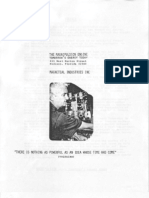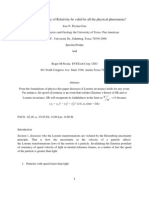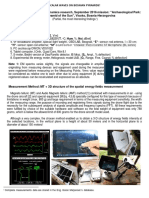IE Pyramid Paper
IE Pyramid Paper
Uploaded by
Stefan Belchuga NikolicCopyright:
Available Formats
IE Pyramid Paper
IE Pyramid Paper
Uploaded by
Stefan Belchuga NikolicOriginal Description:
Copyright
Available Formats
Share this document
Did you find this document useful?
Is this content inappropriate?
Copyright:
Available Formats
IE Pyramid Paper
IE Pyramid Paper
Uploaded by
Stefan Belchuga NikolicCopyright:
Available Formats
See
discussions, stats, and author profiles for this publication at: http://www.researchgate.net/publication/255709759
The Pyramid Electric Generator
ARTICLE AUGUST 2013
CITATION
READS
598
1 AUTHOR:
Peter Grandics
A-D Research Foundation
40 PUBLICATIONS 226 CITATIONS
SEE PROFILE
Available from: Peter Grandics
Retrieved on: 28 October 2015
The Pyramid Electric Generator
Peter Grandics*
Abstract
We describe here an electric generator capable of harvesting
power from Earths electric field. The generator comprises a
geometrically optimized square base pyramid-shaped antenna connected to a set of coils near the pyramids apex. The
coils consist of a coil of high turn number (secondary coil)
positioned coaxially within the primary coil; together, these
function as a resonant step-up transformer winding, as they
are inductively coupled and connected to the pyramidal
antenna, which acts as a quasi-capacitive series element coupled to the surrounding space to provide a specific resonant
frequency. The primary coil is connected to an AC driver
operating in the LF radio band. Activating the primary coil
drives the pyramid to a high AC voltage essential for its
power attraction function. A power of over 7000VA and an
apparent power gain of nearly one hundred-fold have been
measured in the secondary coil relative to the input power.
We have also established the operating principles for the
pyramid electric generator.
Introduction
We have introduced a new theory of space, energy and matter that predicted that electromagnetic interaction propagates through a carrier medium called the space lattice that
is made up of pulsating, phi-based spiral vortices (STAR), the
excitation of which generates propagating sinusoidal lines of
force across the space lattice recorded as electromagnetic
waves by our instruments.1,2 We have also predicted that
natural pressure gradients exist within the space lattice that
can be used for power generation by inserting a capacitor
into such gradient. Furthermore, we proposed that a pyramid-shaped capacitor is an optimally shaped device for tapping the energy gradient of the space lattice that manifests
in the form of an electrical potential gradient in Earths
atmosphere. This was demonstrated subsequently.3-5 We
also found that the pyramid-shaped capacitor design should
be based on ratios of pi and phi5 because electrical energy
propagates along a phi-based spiral.6
We suggested that elemental particles are composed of
STAR oscillators that make up the space lattice by electromagnetic compression of its elemental cubes into pulsating
conical/vortexual subunits that form the basis for all particles of matter.1,2 We proposed that atomic and subatomic
oscillators could vibrate in a very wide frequency range from
sub-acoustic to extremely high EM frequencies.1,2 This does
not mean that material bodies can take or maintain a physical
form at any energy level, but this allows the recycling of atoms
into the space lattice as part of their natural evolution.2,6
Atomic oscillators are constantly in motion, and such
motion is electric because all motion and energy is fundamentally electric.2,6 It is known that atomic bodies con-
stantly exchange electric energy. Such energy flow can be
harvested when the spiral physical nature of electric waves is
recognized. Russell observed that energy always moves during its generative cycle in spirals towards the higher potential7; therefore, we reasoned that an attractor of high electric potential must be provided to pull in the random electromagnetic emissions of atomic oscillators. The attractor
must function as a phi-based antenna/waveguide to focus
the phi-based electric emissions of atomic bodies into the
apex of a vortex, the same method Nature uses for power
multiplication.6,7 Therefore, a phi-based pyramidal antenna/waveguide must be at a high voltage in order to perform
its attractor function.
As all material manifestations are tonal,8 acoustic vibrations are always generated during the oscillations of atomic
bodies, even though they are inaudible most of the time.
Sometimes, however, they are detected; one such example is
Earths hum.9-11 Earths solid mass and its atmosphere represent a coupled resonant system, and is therefore our expanded target power source. Acoustic waves are also electrical8
and can be harvested. To achieve this goal, the geometrically optimized pyramidal antenna/waveguide must be connected to an oscillator that operates at a high voltage and is
Figure 1. Proposed electric vortices propagating across the
pyramidal antenna/waveguide.
MARCH/APRIL 2009 ISSUE 84 INFINITE ENERGY
Table 1. Physical and electrical parameters of the resonant transformer.
Secondary turns of wire
840 turns
Height
0.85 m
0.00081 m
Wire diameter
Primary turns of wire
5+9/10 turns
Height
0.21 m
1/4 O.D. copper pipe with
0.030 wall thickness
Wire diameter
Primary
Inductance
98 H
Resistance
0.118 ohms
Secondary
Inductance
24.16 mH
Resistance
24.42 ohms
Capacitance
Winding ratio
Mutual inductance
Figure 2. Circuit diagram of the pyramid generator.
tuned to a suitably selected frequency.
The appropriate resonant frequency is dictated by practical considerations. Atomic oscillators can vibrate in a very
wide frequency range1,2,6-8 but short wavelength radiations
are readily re-absorbed by atoms and are rapidly attenuated;
therefore, long wavelength electromagnetic emissions must
be targeted. The operation of the pyramid generator is feasible in the ELF to the LF range. As electric radiation propagates in a vortex,2,6-8 the emitted electric vortex over the
pyramidal antenna (Figure 1) increases its size, and so it is
capable of funneling atmospheric electromagnetic emissions
of the same frequency back into the antenna/receiver. Thus,
the pyramid electric generator could capture the energy
emitted by both telluric and atmospheric atomic oscillators.
We have tested these assumptions and demonstrated the
basic principles of an electric generator.
Methods and Results
In our previous papers, we reported that a pyramid-shaped
capacitor/antenna converts atmospheric electrostatic discharge impulses (ESD) into a periodic high-frequency signal
that can be detected in an insulated coil placed in proximity of the capacitor.3,4 Here, we report on further developments including a new design for the resonant coil system
and an expanded range of energy sources targeted. A
Tektronix TPS 2024 digital oscilloscope was used for signal
acquisition and analysis, and Tektronix A503 current amplifiers were used with the Tektronix A6302 and A6303 probes
2
INFINITE ENERGY ISSUE 84 MARCH/APRIL 2009
1040nF
1:142
6.13 mH
for current measurement. High voltage was measured using
a Tektronix P6015 probe. An ENI-1140LA amplifier was used
to activate the primary coil of the resonant coil system at the
selected frequency.
For the experiments, we used a geometrically optimized
pyramid-shaped antenna/waveguide.3-5 The pyramid
expressed ratios of pi and phi and was approximately a 1:125
scaled down replica of the Great Pyramid of Giza, 6 feet base
length. The pyramid was built of a wooden frame and covered with triangular copper sheets of 0.66mm thickness on
its sides that were electrically connected. It was placed on an
insulating base and positioned in the general North-South
direction.
The secondary coil (coil 2) was wound with a 20 AWG
insulated magnet wire with a monofilament nylon spacer
(0.06mm diameter) between the turns on a fiberglass cylindrical coil form, and connected to the conducting surface of
the pyramid near its apex. Thus, the secondary coil was connected with the pyramidal antenna/waveguide as a quasicapacitive series element to provide a specific resonant frequency with coupling to the surrounding electromagnetic
environment. The other lead of coil 2 was grounded (Figure
2). The purpose of the monofilament spacer was to reduce
interwinding capacitance in coil 2 by increasing distance
between wire turns of the coil.
A primary coil of larger diameter (coil 1) was wound on or
near the lower cylindrical volume of coil 2 with the lead connected to Earth ground, and served as a driver coil inductively coupled with the secondary (coil 2). The secondary
was isolated from the primary by layers of silicon rubber and
foam. The two coils make a resonant step-up transformer,
the parameters of which are shown in Table 1.
In the experiment, the controlled variable was the voltage, which was increased in steps until the maximum voltage in the secondary (permitted by circuit components and
test equipment) was achieved for the given resonant frequency. The objective was to drive the atmosphere by radiating a high voltage (~20kV p-p), LF (40-120 kHz) signal
developed by the high ratio step-up transformer and fed by
a powerful signal generator at a resonant frequency either
with an L-C resonant secondary coil, or a resonance determined by the pyramid as a quasi-capacitive series element
connected to the secondary coil of the transformer and radi-
Table 2. Power measurements in the pyramid-resonant coil system.
Primary
Frequency (kHz)
VP RMS
IP RMS (mA)
IP angle with respect to VP
Total power (VA)
True power (W)
83.00
3.97
87.6
18
0.35
0.33
9.86 20.3
300
792
14
22
2.95 16.02
2.87 14.85
26.7
1117
23
29.70
27.35
33.8
1389
21
46.77
43.66
39
1541
20
59.95
56.34
40.8
1838
28
74.75
66.01
vated by a signal from an RF generator via a primary coil of
a few turn numbers inductively coupled to coil 2. The measurement points are also indicated, displaying the positions
of voltage and current probes. The data are captured by a
digital oscilloscope and recorded on a laptop computer.
Discussion
ating to the local atmosphere. The experimental data are
shown in Table 2. The current readings were also confirmed
by using current sensing resistors (not shown). An apparent power gain of nearly 100-fold was achieved in the secondary coil relative to input power in the primary coil, and
a linear increase of power in the secondary coil with the
increase of input power into the primary coil (Figure 3). The
power in the secondary coil exponentially increases with the
pyramid apex voltage (Figure 4).
A load may be connected to coil 2 to draw power from the
system. The load may also be connected via a tertiary coil
inductively coupled to the secondary coil. The load may be
a resistor, a rectifier or storage capacitor powering a DC load.
A graphic representation of the test system is shown in
Figure 5. The pyramidal antenna/waveguide, placed on an
insulating base, is coupled to the surrounding electromagnetic environment and serves as an antenna/waveguide for
the concentration of atmospheric and telluric electromagnetic oscillations at resonance frequency. As the flow of electric energy is always balanced,6 two vortices may cross the
pyramidal antenna: one from the direction of the ground
concentrating into its apex and another one from its apex
propagating into the atmosphere (Figure 1). The atmospheric electric vortex possibly acts as an ionic antenna pulling in
EM radiations from a large atmospheric domain.
The pyramids apex is attached to a coil of high turn number (Figures 2 and 4). This secondary coil wound on a nonconductive coil form serves as a step-up transformer, and
forms a resonant circuit with the pyramid that acts as a
quasi-capacitive series element. The secondary coil is acti-
This study demonstrates a novel approach to harvest Earths
electric energy, including the rational design principles of a
free-energy device. The masses of Earth and its atmosphere
represent a coupled resonant system that is continually electrified by solar radiation. We have found that a pyramidal
antenna designed based on the ratios of phi and pi is optimal for the capture of atmospheric electrostatic discharge
(ESD) impulses.3-5 Atmospheric ESD is a product of solar
radiation and is a wide bandwidth phenomenon. The pyramid as a wideband, non-resonant antenna is uniquely adapted to harvest the energy of atmospheric ESD.
This study also points out an additional energizing mechanism at work during the operation of the pyramid electric
generator. The observation is derived from our theory on
energy, matter and space1,2 as well as that of Russell.6,7 Both
Russell and we observed that spiral motion is a fundamental
action of matter and that the vortex is the mechanism of
power multiplication in Nature. A vortex concentrates
power into its apex where the highest velocity of motion,
the highest pressure and the highest electric potential
resides.1,2,6,7 As electricity propagates along a pulsating phibased spiral,6,7 a phi-based antenna/waveguide is suitable to
focus its energy into the apex of a vortex inside the antenna.
A phi-based pyramid is optimal for this purpose.
As atomic bodies can oscillate in a very wide frequency
range,1,2,6-8 a pyramidal antenna/waveguide coupled to an
oscillator that is tuned to a suitable frequency can focus the
electric noise from Earths atomic oscillators into the apex
of the pyramid that is at a high voltage. Russell observed that
energy moves towards the higher potential during its generative cycle7; therefore, it is essential that the pyramidal
antenna be at a high potential. Our data corroborated this
assumption.
To select a suitable frequency range, one can begin with
the observation that all material manifestations are tonal,8
and that acoustic frequencies are always generated during
the oscillations of atomic bodies even though they remain
inaudible most of the time. Acoustic waves are also electric8
Figure 3. Power in the secondary coil as a function of power in the
primary coil.
Figure 4. Power in the secondary coil as a function of pyramids
apex voltage.
Secondary
VS RMS
IA RMS (mA)
IA angle with respect to VS
Total power (VA)
True power (W)
Power sec/prim
341 1150 3540
4670
6220
7140 7710
62.2
193
438
579
728
834
919
42
44
52
52
54
53
52
21.2 222.8 1552 2707.8 4530.2 5957.5 7087.3
15.7 160.3
956 1668.1 2664.5 3587.6 4366
61.1 75.4 96.9
91.2
96.9
99.4
94.8
MARCH/APRIL 2009 ISSUE 84 INFINITE ENERGY
pyramid structures and coils. As voltage is the primary factor
in attracting power into the system, the necessary voltage
can be provided by the vertical atmospheric potential on a
tall pyramid. Since the atmospheric vertical potential gradient could go as high as 1200V/m near Earths surface under
fair weather conditions,13 a pyramid height of 80-150m
seems sufficient to provide the apex voltage for a self-sustaining power generator. As the pyramid scales up volumetrically, a power generator pyramid of the size range of the
GPG could likely have an output in the hundreds to thousands of megawatts range. Groups of several pyramid electric
generators could be placed within specific geographical
areas, thus combining their energy harvesting capacity.
Acknowledgement
I thank Mike Beigel and Mauricio Jochinsen from Beigel
Technology Corporation for their work with the measurements and their participation in this study. I am also indebted to Mike Beigel and Gregory M. Vogel for their comments
and suggestions on the manuscript.
Figure 5. An outline of the test circuit.
and therefore Earths enormous mass and its atmosphere
represent a coupled resonant system that offer a vast source
of power.
For practical reasons on our small pyramid, we have chosen a frequency above the audio range but below the radio
frequency spectrum; our antenna was made to radiate at the
target wavelength. The wavelength of the 50-120kHz range
is 6km to 25km, thus allowing energy to be harvested over a
large atmospheric domain. As electrical energy propagates in
a vortex,6,7 the emitted electric vortex (ionic antenna) over
the pyramidal antenna/waveguide increases its size and
enables it to funnel the same frequency atmospheric electromagnetic radiations back into the antenna. Thus, the
pyramid electric generator captures at the selected frequency
the energy emitted by Earths atomic oscillators.
The presence of an electric (ionic) vortex was demonstrated by radar testing of the space over a 44m tall fiberglass
pyramid located near Moscow.12 The Russians found that
the large ionized column of air over the area of the vertical
axis of the pyramid had a width of about 500m and reached
an altitude of 2km. It is remarkable that this effect was
induced by a nonconductive pyramid surface demonstrating
a significant degree of atmospheric ionization even under
fair weather conditions. Thus, a suitably sized large or an
electrically activated small pyramid should open a low
impedance path to higher elevations of relatively conductive
atmospheric domains.
In conclusion, the total power that can be extracted from
Earths atomic oscillators must be extremely large, likely far
exceeding current global electric generation capacity. In our
experiment, we obtained over 7000VA power at about 20kV
p-p pyramid voltage using a 6 feet base length pyramid. This
power is nearly 100 times greater than the power necessary
to drive the pyramid to the required operating voltage. By
constructing the pyramid generator from dedicated high
voltage components and using higher drive voltages, a significant increase in power output is envisioned. The power
extraction will also be enhanced by further optimization of
the designs of both the pyramid and the coil system.
The power output will also increase by employing larger
4
INFINITE ENERGY ISSUE 84 MARCH/APRIL 2009
References
1. Grandics, P. 2002. The Genesis of Electromagnetic and
Gravitational Forces, J. New Energy, 6, 3, 33-45.
2. Grandics, P. 2007. The Genesis of Fundamental Forces Acting at a
Distance and Some Practical Derivations, Infinite Energy, 12, 71, 13-24.
3. Grandics, P. 2000. A Method to Capture Atmospheric
Electrostatic Energy, Proceedings of IEJ-ESA Joint Symposium on
Electrostatics, Kyoto University, Kyoto, Japan, pp. 355-361.
4. Grandics, P. 2006. A DC to RF Converter for the Capture of
Atmospheric Electrostatic Energy, Proceedings of the 5th Conference
of the Societe Francaise DElectrostatique, SFE 2006, Grenoble, France,
pp. 279-284.
5. Grandics, P. 2007. Pyramidal Electric Transducer: A DC to RF
Converter for the Capture of Atmospheric Electrostatic Energy,
Infinite Energy, 13, 73, 20-27.
6. Russell, W. 1947. The Secret of Light, 3rd ed., University of Science
and Philosophy, Waynesboro, Virginia, pp. 218-288.
7. Russell, W. 1957. Atomic Suicide?, 2nd ed., University of Science
and Philosophy, Waynesboro, Virginia, pp. 129-153.
8. Russell, W. 1926. The Universal One, University of Science and
Philosophy, Waynesboro, Virginia, pp. 247-249.
9. Nishida, K., Kobayashi, N., and Fukao, Y. 2000. Resonant
Oscillations Between the Solid Earth and the Atmosphere, Science,
287, 5461, 2244-2246.
10. Tanimoto, T., Um, J., Nishida, K., and Kobayashi, N. 1998.
Earths Continuous Oscillations Observed on Seismically Quiet
Days, Geophys. Res. Lett., 25, 1553-1556.
11. Tanimoto, T. 2001. Continuous Free Oscillations: Atmospheresolid Earth Coupling, Ann. Rev. Earth Planet. Sci., 29, 563-584.
12. hwww.pyramidoflife.com/eng/tests_experiments.html.
13. Marshall, T.C., Rust, W.D., Stolzenburg, M., Roeder, W.P., and
Kriebel, P.R. 1999. A Study of Enhanced Fair-weather Electric Fields
Occurring Soon After Sunrise, J. Geophys. Res., 104, 24, 455-24,469.
About the Author
Peter Grandics has an MS in chemical engineering and a
Ph.D. in biochemical engineering. He has worked in the
fields of biomedical research and recently in physics focusing on new energy technologies. He intends to help find
answers to our current global energy challenges.
*A-D Research Foundation, P.O. Box 130966, Carlsbad, CA
92013 ; Email: pgrandics@earthlink.net
You might also like
- The High Energy Electromagnetic Field Generator: Salvatore Cezar PaisDocument6 pagesThe High Energy Electromagnetic Field Generator: Salvatore Cezar PaisBrianNo ratings yet
- Experiment of The Biefield-Brown Effect Using Symmetric Plate Capacitors Charged Below 35kVDocument8 pagesExperiment of The Biefield-Brown Effect Using Symmetric Plate Capacitors Charged Below 35kVLuis Alberto MiglioreroNo ratings yet
- A Unique Discrete Zero-Crossing DetectorDocument2 pagesA Unique Discrete Zero-Crossing DetectorCristian LiviuNo ratings yet
- Antenna Calibration in Anechoic ChambersDocument4 pagesAntenna Calibration in Anechoic ChambersMika Repilika100% (1)
- Pyramidal Electric TransducerDocument7 pagesPyramidal Electric TransducerBenjamin ChiuNo ratings yet
- Nuclear Batteries: Psna College of Engineering and TechnologyDocument16 pagesNuclear Batteries: Psna College of Engineering and TechnologyDddddNo ratings yet
- Gray 4595975Document7 pagesGray 4595975MANNAJANELAGUNA0% (1)
- My Replication JournalDocument31 pagesMy Replication Journalharishkumarsingh100% (1)
- Patent - Paul BabcockDocument25 pagesPatent - Paul BabcockHappyJoeNo ratings yet
- Magneteal IndustriesDocument10 pagesMagneteal IndustrieskishbudNo ratings yet
- The MR Preva ExperimentDocument5 pagesThe MR Preva ExperimentMihai Daniel100% (2)
- Aspden - Physics UnifiedDocument212 pagesAspden - Physics UnifiedHigia Miguelina Herrera Neyerlin100% (1)
- Replication and Study of Kapagene GeneratorDocument8 pagesReplication and Study of Kapagene GeneratoremiroNo ratings yet
- Jon Abel - Resonant Regenerative Fuel Cell V 1.1: Windings & Magnetic Pole LocationsDocument2 pagesJon Abel - Resonant Regenerative Fuel Cell V 1.1: Windings & Magnetic Pole Locationsliga21100% (2)
- Laporan 4 Simple Audio Amplifier PDFDocument9 pagesLaporan 4 Simple Audio Amplifier PDFAzman HanafiahNo ratings yet
- Time and Its Physical Relationships: Andrew MichrowskiDocument8 pagesTime and Its Physical Relationships: Andrew Michrowskikethavarapuramji100% (1)
- Alex Schiffer UpdatesDocument204 pagesAlex Schiffer UpdatesRuddyMartiniNo ratings yet
- COLD FUSION - Nuclear Reactions in Condensed Matter - Basis of A New EnergyDocument15 pagesCOLD FUSION - Nuclear Reactions in Condensed Matter - Basis of A New EnergyXaver FiedlerNo ratings yet
- Alexander Frolov Highly Efficiency ElectrolysisDocument3 pagesAlexander Frolov Highly Efficiency ElectrolysisDan BeesonNo ratings yet
- Antigravity KineticDocument33 pagesAntigravity KineticManojlovic VasoNo ratings yet
- Veljko Milkovic - Two-Stage Mechanical Oscillator - 9 - 1 Overunity and Antigravity..Document26 pagesVeljko Milkovic - Two-Stage Mechanical Oscillator - 9 - 1 Overunity and Antigravity..Erwin BlancoNo ratings yet
- LTseung PDFDocument71 pagesLTseung PDFMAGUS43No ratings yet
- Application of Tesla Technologies in Todays World PDFDocument37 pagesApplication of Tesla Technologies in Todays World PDFCathy AnnNo ratings yet
- US9871431Document10 pagesUS9871431lianshengNo ratings yet
- Cherne TSK IDocument35 pagesCherne TSK Irudy6078100% (1)
- Japan ElectretsDocument5 pagesJapan Electretsxreader0No ratings yet
- Infinity Is Weird Even in Infinite ReactanceDocument6 pagesInfinity Is Weird Even in Infinite ReactanceVinyasiNo ratings yet
- The Double Helix Theory of The Magnetic FieldDocument21 pagesThe Double Helix Theory of The Magnetic FieldNovevacche DemoncowsNo ratings yet
- Global Atmospheric ElectricDocument81 pagesGlobal Atmospheric ElectricCelestial ShamanNo ratings yet
- Electrostatic LevitationDocument3 pagesElectrostatic Levitationshivananda_patraNo ratings yet
- Ray Guns 101: (Part I - History)Document20 pagesRay Guns 101: (Part I - History)CyrrexNo ratings yet
- Dave Lawton Replica of MeyeDocument6 pagesDave Lawton Replica of MeyeVlad AdrianNo ratings yet
- 14744-Texto Del Artículo-72648-1-10-20190408Document12 pages14744-Texto Del Artículo-72648-1-10-20190408GeorgeNo ratings yet
- Ответы Дона СмитаDocument5 pagesОтветы Дона СмитаVasily VorobyovNo ratings yet
- PieEconomics - Cavitation Radiation ReplicationDocument26 pagesPieEconomics - Cavitation Radiation ReplicationshizuyeNo ratings yet
- Soliton WavesDocument42 pagesSoliton WavesAbdalmoedAlaiashyNo ratings yet
- 12V Battery Powered Marx GeneratorDocument14 pages12V Battery Powered Marx Generatorpakde jongko100% (1)
- 2017 Demeo Water ConfDocument33 pages2017 Demeo Water ConfengineeringtheimpossibleNo ratings yet
- CWT IdeologyDocument116 pagesCWT IdeologyЕкатерина РодионоваNo ratings yet
- How Elements Are FormedDocument26 pagesHow Elements Are FormedIris LeuterioNo ratings yet
- Parametric ResonatorsDocument66 pagesParametric ResonatorsWellu JutilaNo ratings yet
- Correspondence 030706 - MaxwellDocument9 pagesCorrespondence 030706 - Maxwellgong688665No ratings yet
- So No Luminescence ImplosionDocument191 pagesSo No Luminescence ImplosionVincent J. Cataldi100% (1)
- Scalar Superpotential Theory PDFDocument11 pagesScalar Superpotential Theory PDFwroueawe100% (1)
- Bifilar CoilDocument2 pagesBifilar CoilEl Zaky RizkiNo ratings yet
- Is Einstein Theory of Relativity CorrecDocument3 pagesIs Einstein Theory of Relativity CorrecJose PecinaNo ratings yet
- Electric Discharges, Waves and ImpulsesDocument170 pagesElectric Discharges, Waves and Impulseselectrosci100% (1)
- Dave Nelson On Edward Leedskalnin (13 Pages)Document55 pagesDave Nelson On Edward Leedskalnin (13 Pages)theherbsmithNo ratings yet
- REGAUGINGDocument5 pagesREGAUGINGaardsnailNo ratings yet
- A Practical Guide To Free Energy DevicesDocument49 pagesA Practical Guide To Free Energy DevicesZerOMegANo ratings yet
- Correct D2O Cold Fusion Reactor With Strong Alkaline ElectrolyteDocument4 pagesCorrect D2O Cold Fusion Reactor With Strong Alkaline ElectrolyteInternational Journal of Innovative Science and Research Technology100% (1)
- Impulse Power Secrets-3docDocument8 pagesImpulse Power Secrets-3doc77nicuNo ratings yet
- An Invention Possibly Greater Than The WheelDocument8 pagesAn Invention Possibly Greater Than The WheelVeljko MilkovicNo ratings yet
- Scalar Waves On Bosnian PyramidsDocument16 pagesScalar Waves On Bosnian Pyramidsdeveta100% (1)
- Testatika Generator and Over-UnityDocument2 pagesTestatika Generator and Over-UnityzcrackNo ratings yet
- Nuclear Alternative: Redesigning Our Model of the Structure of MatterFrom EverandNuclear Alternative: Redesigning Our Model of the Structure of MatterNo ratings yet
- Research Report: Electricity and Gravity, Tornadoes and Hurricanes, Other PhenomenaFrom EverandResearch Report: Electricity and Gravity, Tornadoes and Hurricanes, Other PhenomenaNo ratings yet
- RRU Function PRESENTATION 2Document9 pagesRRU Function PRESENTATION 2Vincent T. JosephNo ratings yet
- Guide Lines of Training Report For 5th SEMDocument26 pagesGuide Lines of Training Report For 5th SEMMayan KansalNo ratings yet
- 5G BasicsDocument18 pages5G BasicsErikrish60% (5)
- Institute of Aeronautical Engineering (Autonomous) : Electronics and Communication EngineeringDocument32 pagesInstitute of Aeronautical Engineering (Autonomous) : Electronics and Communication EngineeringMano Har0% (1)
- Riyadh-Riyadhdst Dias10318Document2 pagesRiyadh-Riyadhdst Dias10318Muhammad ShahidNo ratings yet
- Operating Instructions For Your Cobra 29 LTD BTDocument21 pagesOperating Instructions For Your Cobra 29 LTD BTManga ShurikenNo ratings yet
- Synthesis of Microstrip Antenna (Rectangular Structure) Using HFSSDocument12 pagesSynthesis of Microstrip Antenna (Rectangular Structure) Using HFSSanilNo ratings yet
- Turnstile Antennas: Prepared By: Abueva, Marcos Marcelon Jr. ADocument15 pagesTurnstile Antennas: Prepared By: Abueva, Marcos Marcelon Jr. AMarcos Marcelon Alcantara Abueva IIINo ratings yet
- Wireless RadioTechnologyDocument28 pagesWireless RadioTechnologyIT Hub SLNo ratings yet
- Coverage Optimization: 秘密 Proprietary Confidential▲Document24 pagesCoverage Optimization: 秘密 Proprietary Confidential▲DativaNo ratings yet
- RF 5382h Cu001 150w CouplerDocument2 pagesRF 5382h Cu001 150w CouplerChrisLevoNo ratings yet
- Digital Microwave Radio: 1. Introduction To DMRDocument14 pagesDigital Microwave Radio: 1. Introduction To DMRgeraldstar22No ratings yet
- Optimized 2 Yaguis 144 Eme SystemDocument11 pagesOptimized 2 Yaguis 144 Eme SystemAndhi AerosupplyNo ratings yet
- Gsm900/Dcs1800 Chimney Antenna (17/18 Dbi) : Technical SpecificationsDocument3 pagesGsm900/Dcs1800 Chimney Antenna (17/18 Dbi) : Technical SpecificationsDien HuongNo ratings yet
- Ultrawide Band Antenna PresentationDocument24 pagesUltrawide Band Antenna PresentationmeenaNo ratings yet
- 3.6 EME Compliance For IBC and DAS SystemsDocument47 pages3.6 EME Compliance For IBC and DAS Systemsblacknight_81No ratings yet
- User Guide SLF-H - 253255964-D - Ed.04 para ImprimirDocument114 pagesUser Guide SLF-H - 253255964-D - Ed.04 para ImprimirpabloyarceNo ratings yet
- Antenna Specifications: Electrical PropertiesDocument3 pagesAntenna Specifications: Electrical PropertiesRobertNo ratings yet
- iF111S iF121S iF211S iF221S: Instruction ManualDocument20 pagesiF111S iF121S iF211S iF221S: Instruction ManualMiguel PerezNo ratings yet
- CSADDocument3 pagesCSADGhe PataniNo ratings yet
- Antenna Semi Vertical 7 BandasDocument6 pagesAntenna Semi Vertical 7 BandasTeodoro LeónNo ratings yet
- FlexiHopper XC Datasheet Eng 2007Document2 pagesFlexiHopper XC Datasheet Eng 2007Vipin SagarNo ratings yet
- Dual-Band Circularly Polarized Pentagonal Slot Antenna: Y. SungDocument3 pagesDual-Band Circularly Polarized Pentagonal Slot Antenna: Y. SungRifaqat HussainNo ratings yet
- Andrew Antenna 123 ManualDocument9 pagesAndrew Antenna 123 ManualLuis Ivan GualotuñaNo ratings yet
- Which Module To Use ACDC RF WaveOptics PDFDocument4 pagesWhich Module To Use ACDC RF WaveOptics PDFminaya2008No ratings yet
- Part XI Radios For Russian MotorcyclesDocument41 pagesPart XI Radios For Russian MotorcyclescalinkgbNo ratings yet
- Pdms India. (Partial Discharge Monitoring Services India)Document17 pagesPdms India. (Partial Discharge Monitoring Services India)VISHAL TELANGNo ratings yet
- Hyperworks 0120 Brochure EM A5-WebDocument4 pagesHyperworks 0120 Brochure EM A5-WebUdhamNo ratings yet
- Instant Download Electromagnetics 1st Edition Branislav M. Notaros PDF All ChaptersDocument85 pagesInstant Download Electromagnetics 1st Edition Branislav M. Notaros PDF All Chaptersbedoyaborku100% (5)

























































































